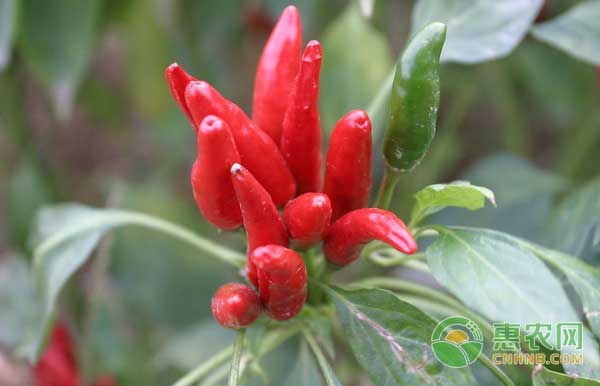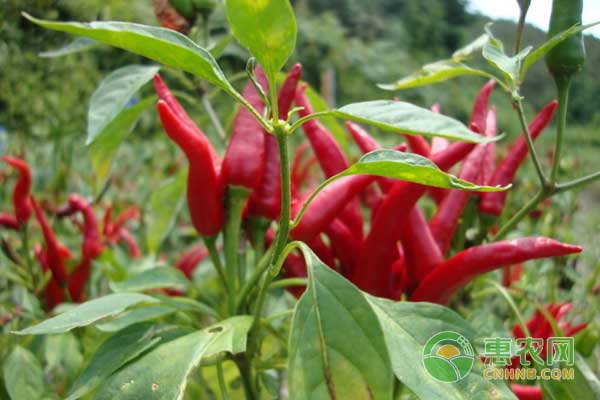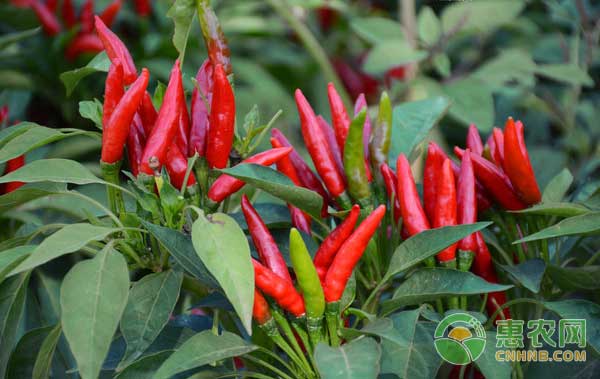Everyday cooking is inseparable from chili, which is not only a very important condiment, but also a nutritious vegetable. Want to grow peppers first need to understand the growth habits of pepper and scientific cultivation management techniques, let's talk about how to plant the open field peppers? Peppers are warm, afraid of cold frost, not only light and afraid of exposure, but also moist and afraid of water, more resistant to fertilizer, suitable for planting in medium or light loam with light saline, good permeability, fertile, water and fertilizer. Under open field conditions, it is usually planted by spring seedling transplanting. It is planted in late February to early March, planted in mid-April, and harvested in batches in mid-to-late June. The average yield per mu is 2266 kg and the average output value per mu is 3399 yuan. The average investment in mu is 1827 yuan, and the average income per mu is 1572 yuan. First, growth habits and environmental conditions 1. Temperature: The pepper is warm, not resistant to low temperature and cold, and high temperature and heat. The initial temperature of seed germination is 12 ° C, the suitable temperature is 25 ~ 30 ° C, when the temperature exceeds 35 ° C or below 10 ° C, the germination is poor or can not germinate; the suitable temperature for growth and development is 20 ~ 30 ° C, daytime 26 ~ 27 °C, night 15~16°C, temperature difference 10°C is suitable; when the temperature is lower than 15°C, growth and development are hindered, and when it is lower than 12°C, it can be harmed. If it is lower than 5°C, it is easy to suffer from cold damage and death. The suitable temperature for firming is 20~25°C, higher than 35°C. The flower is not fully developed or the stigma is dry and can not be fertilized and fallen; the temperature of fruit development and color conversion is above 25°C; the temperature is suitable for the whole growth period of pepper is 12~35°C. If it is lower than 12 °C, it will stop growing. If it exceeds 35 °C, it will be cooled by watering measures. 2, light: pepper is a short-day crop, hi light, afraid of exposure, has a strong adaptability to the light time. Regardless of the length of sunshine, as long as there is suitable temperature and good nutritional conditions, pepper can smoothly carry out flower bud differentiation; strong light is easy to induce the increase of pepper virus disease and sunburn; light is weak, too tight between rows, easy to cause falling flowers Fruit drop; seed germination requires dark conditions, but plant growth requires good light. 3, water: pepper is not drought-tolerant, not resistant to phlegm, the plant itself does not require a large amount of water, but because the root system is not very developed, it needs to be watered frequently to grow well. Generally, large fruit varieties require more water, and small fruit varieties require less water. Seeds need to absorb enough water for seed germination; plants need less water during seedling stage, and the ground should be kept dry and wet; if the soil moisture is too high, the roots will Dysplasia, resulting in long and slender; the initial flowering water requirement increases with the growth of the plant, but too much humidity will cause the flower to fall; the fruit expansion period needs sufficient water, the water supply is insufficient, affecting the fruit expansion, if the air is too dry, It will also cause falling flowers and fruit. Therefore, it is an important measure to obtain high quality and high yield by supplying enough water and keeping the ground moist. 4. Soil and nutrition: Pepper can be planted on soil of different textures, but it is most suitable for loam or sandy loam soil with high dryness, good drainage, thick soil layer, rich organic matter and light saline. In terms of nutritional needs, the demand for N and K is large, and the demand for P is relatively small. The ratio of N, P and K is 1:0.5:1. During the seedling stage of pepper, the plant is young and absorbs less nutrients, but the fertilizer quality is high. In the early flowering period, excessive application of N fertilizer should be avoided to prevent the plant from growing, delaying the flowering and fruit setting; the fruiting period is the N, P and K fertilizer demand. At the peak, the absorption of N, P, and K accounted for 57%, 61%, and 69% of the total absorption, respectively; N fertilizer for branch and leaf development, P and K fertilizer promoted root growth, fruit enlargement, and fruit promotion. Coloring; generally 1 time for each harvest. Second, supporting cultivation techniques (1) Selecting excellent varieties Choose pepper varieties with disease resistance, concentrated fruit set, low-salt fruit, good color of pepper and fruit, moderate spicy taste and high yield potential. Such as: 陇 pepper No. 2, pig large intestine. 1. Qijiao No. 2: It is a hybrid of early maturing generation. The variety has strong growth potential, plant height 80 cm, antiviral disease, and resistance to blight; the plant has a diameter of 70 cm; the fruit has good commerciality, fruit horn shape, fruit shape, fruit length 25 cm, fruit width 3 cm, single fruit weight 35 Gram; fruit wrinkle, fruit green, spicy, good quality; vitamin content of 158.4 mg / 100 g fresh weight; general yield of about 4000 kg per mu, suitable for open field cultivation. 2. Pig large intestine: medium growth, loose plant type; plant height 95 cm, development degree 55 cm, the beginning of the 10th section of the flower inflorescence; fruit long cone, thicker, curved wrinkles like pig large intestine, single fruit weight 100 ~ 200 Gram; thick flesh, spicy, quality in the middle; medium maturity and high yield, generally 2,000 to 4000 kg per mu. (2) Cultivate age-appropriate seedlings 1. Preparation of seedbed: selected leeward sun, flat terrain, easy to irrigate, deep and fertile soil, good permeability, light salt and alkali, no planting of tomato, eggplant, potato, pepper, fertile land with high organic matter content. Or the courtyard is free to dig into a 15 cm deep, 1.2 to 1.5 m wide, 10 m long seedbed, which is convenient for seedlings, ventilation and refining during seedling maintenance, and keep the bed surface flat. 2. Nutrient soil preparation: The amount of fertilizer required for the seedling stage of the pepper is not large, and the nutrient is required to be balanced and comprehensive. According to the ratio of 3:2 of Datian mature soil and decomposed organic fertilizer, sifted nutrient soil; in each cubic nutrient soil, add 1 kg of NPK three-element compound fertilizer, 100 g of fungus or carbendazim, and trichlorfon 100 Gram, mix well and mix well to prevent root burning. 3. Nutrient soil decoration: The nutrient soil to be prepared should be filled with 10×8 cm nutrition 按 according to the technical requirements of 2 cm of the upper Panasonic and the soil surface of the nutrient sputum. Put the carcass filled with nutritious soil neatly and tightly placed in the seedbed for broadcasting. In actual production, many farmers are too nutritious, spend a lot of money, occupy a lot of land, and spend a lot of money. Instead, they use small nutrients to raise seedlings, resulting in small seedlings, less roots, and weaker growth. Requirements, which affect production and time to market. 4. Seed treatment: 1 Sun-breeding: Select the sun for 2 days before sowing to increase the germination potential and germination rate. 2 soaking seeds and disinfection: put the dried seeds into 55 ° C warm water (3 parts boiling water + 1 part cold water), soak and stir for 15 minutes; then soak seeds with 10% trisodium phosphate solution for 15 minutes; then rinse the seed coat with water Mucus, add cold water to 35 ° C, soak seeds for 6 to 8 hours, drain the water, to be germinated. 3 germination: the method is to spread the immersed, disinfected seeds on a clean, moist cotton cloth, after wrapping, moisturizing with a plastic bag, placed under 30 ° C dark conditions to germination. During the germination process, the seed bag is opened and turned every day to make the seed breathable and evenly heated. Generally, after 4-5 days, after 70% of whitening, the seeding can be selected on a sunny day. In actual operation, there is often a phenomenon that the germination temperature is too high, the scalded seed or the temperature is lower than the germination temperature, and the bud is not germinated; some seeds are too humid, the cloth is too wet, the seeds are too much, and the accumulation is thick, and the effect is affected. Gas exchange, poor ventilation, and the phenomenon of boring and rotten species. Therefore, when germination, we must grasp the moisture, temperature and air to improve the quality of germination. 5. Seeding 1 Sowing date: using small arch shed seedlings, generally from the end of February to the beginning of March, when the lowest temperature in the shed is stable through 15 °C, it can be sown. 2 Sowing amount: 50 grams of dry seeds are planted per acre, and seeds are prepared. 3 sowing methods and technical requirements: the seeds of white buds are artificially planted in the center of the nutrient sputum, lightly pressed, and the seeds are placed on the soil on three sides; then the soil is mixed with the nutrient soil mixed with the seedlings or carbendazim + trichlorfon. Covering soil thickness of 0.8~1cm to prevent the occurrence of squatting disease; immediately after sowing, use 2m long willow bar, 80cm apart, build arch frame, and fill small water, infiltrate nutrient bauxite from bottom to top 3/4, buckle The shed film, warming and moisturizing, and preventing the "wearing cap" unearthed. 6. Seedbed management 1 Temperature regulation: According to the principle of “three highs and three lowsâ€, the greenhouse film should be opened and closed scientifically and properly, and the temperature of each growth stage should be adjusted. That is, the temperature before emergence is high, the ground temperature is 25 ~ 30 ° C, the temperature is 28 ~ 32 ° C; the temperature after emergence is low, 25 ~ 28 ° C during the day, 10 ~ 13 ° C during the night; the temperature after the heart leaves unfolding is high, 28 ~ 30 ° C during the day, 13 at night ~ 15 ° C; low temperature before seedlings, 25 ~ 26 ° C during the day, 10 ~ 13 ° C during the night; high temperature after seedlings, 28 ~ 30 ° C during the day, 15 ~ 20 ° C during the night; low temperature before planting, low temperature training, daytime 23 to 25 ° C, 10 ° C at night. 2 humidity control: should grasp the principle of "both adequate, but not wet", targeted hydration or dehumidification. Under the premise of pouring the bottom water at the time of sowing, generally, there will be no shortage of water when the seedlings are seeded; if the humidity is too large, the soil can be sieved to the bed surface without water droplets, and if the bed soil is too dry, it may be appropriate. Watering with a watering can, but not too much, to keep the soil moist. 7. Strong seedling standards: robust pepper seedlings are generally 45 to 50 days old, with a plant height of 18-25 cm; the stems are thick and strong, the internodes are short, and the stems are 0.3 cm thick; there are 8-14 slices of true leaves, and the cotyledons are intact. The true leaves are dark green, the leaves are large and thick; 70%-80% of the plants have large buds; no pests and diseases; the roots are developed and have strong vitality. The pepper seedlings with the above conditions have strong resistance to stress, and the seedlings are quick and easy to survive after transplanting. (3) Planting field management 1. Irrigation through the bottom water: On the basis of autumn and winter irrigation, spring irrigation is carried out from the end of March to the beginning of April. The salt and alkali are stored, and the bottom is filled with water. The irrigation capacity is 60 cubic meters. 2. Apply enough base fertilizer: Capsicum needs more phosphorus and potassium fertilizer than nitrogen fertilizer. Before ploughing the ground, apply 3,000 kg of high-quality farmyard manure or 200 kg of high-concentration refined organic fertilizer per mu, and special NPK compound fertilizer for high-phosphorus-potassium content 50 Kg (or 15 kg of three phosphate fertilizer, 25 kg of urea, 25 kg of potassium sulfate) and 1 kg of boron fertilizer. 3. Rising from the ground: On the basis of applying the base fertilizer, it is suitable for ploughing and ploughing 30 cm, and timely repairing and retaining the residual film of the wreckage to achieve “qi, flat, loose, broken, clean and transparentâ€. "Standard standard; after land preparation, according to the ridge bottom width of 70 cm, the bottom of the ditch is 50 cm wide, the ridge height is 20 cm, the ditch is ridged, and the film is covered. 4. Elimination of closure before planting: In order to effectively prevent field weeds, it should be combined with soil preparation, targeted selection of herbicides, and soil closure. According to the use of "acetochlor" original drug 100-120 ml or 33% "Shi Tianbu" emulsifiable concentrate 150-200 ml, 40 kg water, evenly spray, shallow 耙 4-6 cm, soil closure, the main Control grass weeds and some broadleaf weeds. 5. Timely colonization: Open field pepper should be transplanted and planted in the middle and late April, when the seedling age is 45 to 50 days, the seedling height is 18 to 25 cm, and the number of main stem leaves is 8 to 14 pieces. The ridges are covered with capsicum, usually in a (40 cm + 60 cm) × 25 cm colonization mode, with a planting density of 5,333 plants per mu and a harvesting density of 4,533 plants (85% seedling rate). When planting, firstly drill holes and then water in the hole according to the row spacing; when the water seeps 2/3, remove the seedlings from the nutrient mash, stretch the seedling roots, place the soil in the planting hole, and avoid the roots. After the cover soil is buried to the junction of the rhizome. 6. Management of water and fertilizer after planting: timely planting water after planting; 3 to 5 days after pouring the seedling water; after the door pepper sits, the water-soluble NPK compound fertilizer is applied 6 to 8 kg per mu. According to the principle of “collecting once and topping up onceâ€, the water-soluble NPK compound fertilizer is applied 8 to 10 kg per acre. The flooding of capsicum fruit is the main cause of large-scale death of pepper. It is necessary to lightly water and water the water. The water volume should not be too large. It is better to pour the semi-ditch water. The rigorous flooding of the water over the ridge surface. Water phenomenon should be drained immediately. 7. Preservation and fruit preservation: Spraying foliar potassium dihydrogen phosphate 150~200g+urea 100g/mu at the flowering stage to supplement nutrition. 8. Pest control 1 Viral disease: Capsicum virus disease is mainly based on prevention, and is sprayed with virus speed 1000-2000 times solution or 20% virus A 500-700 times solution or 20% virus spirit 500 times solution. 2 Disease: It can be sprayed with 77.2% Plex water 800 times solution or 75% chlorothalonil WP 800 times liquid spray; once every 7-8 days, it can be controlled once every 2 to 3 times. 3 mites: use lO% imidacloprid or 2.5% deltamethrin emulsifiable powder 2000 ~ 3000 times liquid spray control. 4 spotted fly: 20% spotted net 1500 ~ 2000 times liquid or 10% latent kill 800 ~ 1500 times liquid spray control. 9. Harvest at the right time The fruit was ripely harvested in batches 60 days after flowering. Fruit picking should not be carried out when picking fruit to avoid stabbing other fruits. In order to avoid rotten fruit and cracked fruit, it should be harvested during the color change period or semi-ripe period. The above is the cultivation technology of pepper open field, the content is for reference only, if you want to know more about agricultural technology, please pay attention to Hui Nong School!
System for Indoor Camera home monitoring
Home monitoring is to use network technology to connect the video, audio, alarm and other monitoring systems installed
WiFi camera 1080P hidden The PoE switch provides power and data from a single point, using Power over Ethernet (PoE) over a single Cat-5 cable. It can be used for any 10/100/1000Mbps link and supply industry-standard IEEE 802.3af/at power. Advanced auto-sensing algorithm gives power to 802.3af/at end devices, In addition, the PoE switch automatically determines PoE WiFi network requirements, speed, duplex, and cable type using Auto Uplink. Easy to operate and reliable. camera mini hidden wifi Indoor Camera,Wireless Indoor Camera,Video Wi-Fi Surveillance Camera,WiFi Surveillance Camera Shenzhen Fuvision Electronics Co., Ltd. , https://www.outdoorsolarcamera.com


The PoE switch is ideal for powering PoE devices such as IP cameras, WLAN access point, IP phones, office access control systems, and other PD devices and offers a line of high quality products that provide a total solution for Ethernet application in different environments. hidden cameras
Features
8*10/100/1000mbps POE port,UP-Link 2*1000m RJ45 port+2*1000m SFP
100m Transmission Distance,1-8 port support VLAN mode
Compatible with IEEE802.3AF/AT
The specification of the built-in power supply: 120W (52V 2.3A) Full duplex
All port supported by MDI/MDIX auto flip and self negotiation
Supply 8pcs 10/100/1000Mpbs adaptive high speed forwarding data packet non-lost port.
Each port max. power supply reached 30W.
Low heat design, safe and reliable, high stability
Application: Wireless Access Point² IP Camera
Ultra-detailed open field pepper planting technology (recommended collection)